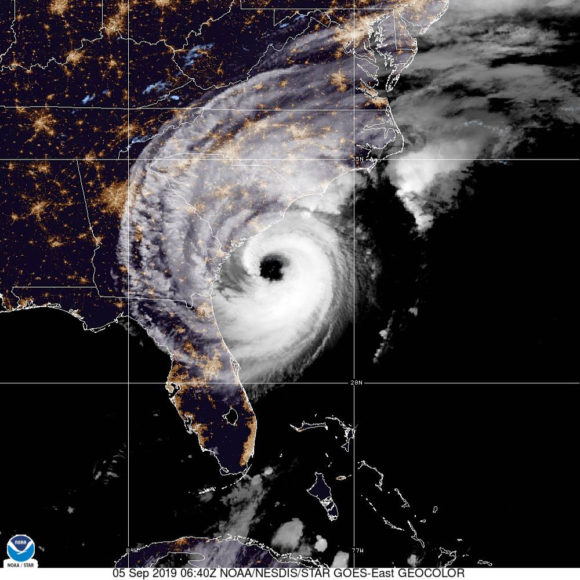Insured loss estimates for Hurricane Dorian will range from $500 million to $1.5 billion, according to catastrophe modeling firms Karen Clark & Co. and RMS.
According to KCC, Dorian reached peak intensity of 185 mph while over the Bahamas, one of only four storms in the Atlantic basin since 1900 to reach this intensity.
In the U.S., Dorian made landfall off the coast of Cape Hatteras, North Carolina, on Sept. 6 as a Category 1 hurricane with maximum sustained winds of 90 mph. It brought some heavy rains and storm surge to the coast of South Carolina, but nothing like what was originally anticipated when it began heading towards the Southeast coast as a Category 3.
It ultimately stayed mostly offshore, bringing some flooding and damage but mostly sparing the region – a dramatic difference than what Dorian did to the Bahamas where it hit several islands with 210 mph winds.
“While Dorian caused material damage in several states, the overall impact to the U.S. could have been much worse had the storm taken a different track,” said Jeff Waters, senior product manager, RMS North Atlantic Hurricane Models. “We were fortunate that the majority of Dorian’s damaging winds and storm surge remained offshore as it tracked along the U.S. coastline, before weakening, and eventually making landfall in North Carolina.”
Based on the KCC high-resolution Hurricane Reference Model, KCC estimates that the total insured loss from Hurricane Dorian in the U.S. and Caribbean will be close to $5 billion.
The industry loss estimate for the U.S. includes the privately insured wind and storm surge damage to residential, commercial, and industrial properties and automobiles. It does not include NFIP losses. The loss estimates for the Caribbean include insured losses to commercial, residential, and industrial properties and do not include automobiles.
KCC said it does not provide losses by state but about 40% of the $1.5 billion U.S. insured losses will be from North Carolina.
Wind damage in the U.S. was concentrated in North and South Carolina, KCC said, and storm surge in Cape Hatteras, N.C., was around seven feet. Other areas along the coast, such as Charleston, S.C., experienced two to three feet of storm surge. KCC said widespread low-level wind damage from tropical storm force winds also impacted Florida, Georgia and Virginia. Hurricane force winds were only experienced in coastal areas of North and South Carolina.
| Breakdown of Insured Loss ($ millions) | |
|---|---|
| Bahamas | 3,620 |
| Puerto Rico | 23 |
| US Virgin Islands | 84 |
| US | 1,500 |
| Total | 5,227 |
The most severe flood damage occurred on the Outer Banks of North Carolina. On Ocracoke Island, the first floors of residential and commercial buildings were flooded.
Global risk modeling and analytics firm RMS said U.S. insured losses will be between $500 million and $1.5 billion. This estimate represents insured losses associated with wind and storm surge damage across the U.S., including losses to the NFIP.
According to RMS, this loss estimate for the U.S. reflects property damage and business interruption to residential, commercial, industrial, and automobile lines of business. Insured losses due to post-event loss amplification and precipitation-induced inland flooding are not expected to contribute significantly to overall U.S. insured losses.
RMS estimated insured losses from wind and storm surge in the Caribbean will be between $3.5 and $6.5 billion. The highest proportion of total insured loss from the storm will stem from the Bahamas.
Insured losses will constitute a fraction of the total economic losses, particularly in the Caribbean, as it has a lower rate of insurance take-up than the U.S., RMS said.
The RMS insured losses estimates for Hurricane Dorian are based on RMS industry exposure databases representing insured hurricane exposure in the Caribbean, U.S., and Canada. Wind and storm surge impacts were simulated using version 18.1 RMS North Atlantic Hurricane Models and RMS ensemble footprints, which are hazard reconstructions of Dorian’s wind and storm surge fields.
Topics Catastrophe USA Profit Loss Flood Hurricane North Carolina South Carolina
Was this article valuable?
Here are more articles you may enjoy.



 Disney Worker Injured Trying to Stop Runaway Boulder at Indiana Jones Show
Disney Worker Injured Trying to Stop Runaway Boulder at Indiana Jones Show  2 New Jersey Pilots Killed in Helicopter Collision Frequented Nearby Cafe Together
2 New Jersey Pilots Killed in Helicopter Collision Frequented Nearby Cafe Together  2025 Was One of Three Hottest Years on Record: Researchers
2025 Was One of Three Hottest Years on Record: Researchers  FBI Involved After Two Florida Injury Lawyers Go Missing From Fishing Trip
FBI Involved After Two Florida Injury Lawyers Go Missing From Fishing Trip 


